Table of contents
The pomegranate or grenadine ( Punica granatum) is a fruit that has attracted a lot of attention as a superfood. The raw edible pomegranate seeds, which are also available in organic quality, are particularly good in a wide variety of salads and desserts.
Use in the kitchen
Is grenadine a fruit? The pomegranate or grenadine is a fruit whose edible part is the seeds inside the fruit, which are covered in red, juicy pulp. The hard shell and the white membranes between the seeds are not eaten. Can you eat pomegranate raw? The pomegranate seeds, which are usually eaten raw, taste refreshingly sweet and sour with a subtle bitter note. What is grenadine? Grenadine and pomegranate mean one and the same thing. But be careful: in some places grenadine is synonymous with grenadine syrup.
Removing the seeds from the fruit is a bit of work. The best way to do this is to cut a wedge-shaped piece out of the calyx and then break the fruit apart while holding it over a bowl. This will cause many seeds to fall out. The remaining seeds can be removed by breaking them out with your fingers or by hitting the back of the fruit halves with a rolling pin, spoon or something similar and knocking the seeds out that way. The bitter, light-colored membranes between the two should be removed. If you want to avoid splashing, you can core the fruit in a bowl of water. Another advantage of this method is that the seeds sink to the bottom while the skins float to the top and can be easily disposed of.
The seeds are wonderful as a decoration for all vegetarian and vegan dishes, but they also add a flavor to many recipes. A wide variety of salads with pomegranate seeds are particularly recommended: combined with other fruits such as pears and oranges and served onlettuce, lamb's lettuce or spinach, or with oriental spices and herbs (e.g. cardamom, cinnamon, turmeric, nutmeg, coriander, Moroccan mint) on couscous or quinoa. Rice bowls, so-called Buddha bowls, can also be enriched with pomegranate seeds. The seeds also make an excellent addition to fruity dessert creations such as fruit salads, layered desserts (e.g. with vanilla cream), shakes, cakes and tarts. They are best used in muesli, smoothie bowls, on vegan rice pudding or as a topping for pancakes at a hearty breakfast or brunch.
In addition to the seeds, pomegranate juice is also becoming increasingly popular. You can easily squeeze this from the fruit yourself by cutting it in half and squeezing it with a citrus press, for example. You can use the fresh juice pure, to mix healthy juice or smoothie combinations, or as an ingredient in fruity salad dressings. Can you make syrup from grenadine? You can also process the grenadine juice into pomegranate syrup or grenadine syrup, which is used, for example, in the famous "Tequila Sunrise" cocktail. Nowadays, a distinction is made between pomegranate syrup and grenadine syrup, as grenadine syrup can be a mixture of different berries and often contains fruit flavors,vanilla, colorings and preservatives, while pomegranate syrup basically only consists of pomegranate juice and sugar.
Vegan recipe for summery avocado and pomegranate salad
Ingredients (for 4 people): 4 avocados (ripe), 1 pomegranate (raw, organic), ½ bunch of mint, 1 lemon, 2 cloves of garlic, 3 tbsp tahini, 125 ml vegan yoghurt (e.g. soy yoghurt), 30 ml water, ½ tsp salt, ¼ tsp cumin (ground), ¼ tsppepper, 1 pinch of cayenne pepper, 1 pinch of coriander seeds (ground).
Preparation: Squeeze the lemon. Peel the garlic cloves and press them too. Mix tahini with vegan yoghurt, water, half of the lemon juice, garlic and salt. Add cumin, pepper, cayenne pepper and coriander and mix well. Cover the dressing and leave to steep briefly in a cool place. Rinse the mint, shake dry and chop roughly. Halve the avocados, remove the seeds and separate from the skin. Cut the avocado halves crosswise into thin slices and drizzle with a little lemon juice. Cut the pomegranate open and remove the seeds. Arrange the avocado slices on plates, pour the tahini-yoghurt dressing over them and scatter the pomegranate seeds on top. Sprinkle the summery salad of avocado and grenadine (vegan) with mint and serve. If you like, you can garnish it with a handful of nuts or pistachios.
Vegan recipes with pomegranate can be found under the note: " Recipes that have the most of this ingredient ".
| Not only vegans or vegetarians should read this: Vegans often eat unhealthily. Avoidable nutritional errors. |
Purchasing - Storage
Most supermarkets such as Coop, Migros, Denner, Volg, Spar, Aldi, Lidl, Rewe, Edeka, Hofer, Billa etc. have pomegranates on offer. Often you can find not only the whole fruit, but also pomegranate seeds packaged ready to eat or frozen. Organic supermarkets (e.g. Alnatura, Denn's Biomarkt) also offer grenadine or its seeds - in organic quality (organic). If you have an oriental or Turkish greengrocer nearby, you will most likely find pomegranates there too. Pomegranates are in season between August and December in countries such as Spain, Israel and Turkey. 19
The availability of pomegranates varies depending on the size of the store, catchment area, etc. If you are interested, click on our recorded food prices for the DA-CH countries (above under the ingredient image). There you will find current prices from various supermarkets and their price development.
Storage tips
Pomegranates are easy to store because they do not ripen after harvesting. You can simply store them at room temperature - this way they will last for about 2-3 weeks. In the fridge, the fruit will even last up to several months. The removed pomegranate seeds can be stored in an airtight container in the fridge for a few days. Alternatively, you can freeze them, which extends their shelf life to months.
Ingredients - Nutritional values - Calories
Pomegranates (raw) contain 83 kcal per 100 g, which mainly come from carbohydrates. Of the 19 g of carbohydrates per 100 g, 14 g are sugar, which covers 15.2% of the daily sugar requirement. The protein content is 1.7 g and the fat content 1.2 g per 100 g. The fiber content is 4 g/100g. 2
Does pomegranate contain vitamin K? Raw pomegranates contain 16 µg of vitamin K per 100 g - that's 22% of the daily requirement.Blueberries (19 µg/100g) and blackberries (20 µg/100g) have comparable amounts. Swiss chard contains a particularly high amount of vitamin K, at 830 µg/100g. One fruit that contains significantly more of the vitamin is the kiwi (40 µg/100g). 2
Raw grenadine contains 38 µg/100g of folate (folic acid) (19% of the daily requirement). Mango (43 µg/100g) and papaya (37 µg/100g) contain a similar amount. Edamame contains a lot of folate (303 µg/100g). Of all the fruits , avocado has the most folic acid at 81 µg/100g. 2
The vitamin C (ascorbic acid) content is 10 mg per 100 g (13% of the daily requirement). This is comparable to that of apricots (10 mg/100g), avocados (10 mg/100g) and cranberries (12 mg/100g). Sea buckthorn berries contain 45 times more vitamin C (450 mg/100g). 2
The complete ingredients of the pomegranate, the coverage of the daily requirement and comparison values with other ingredients can be found in our nutrient tables. In the article Nutrients explained you will get a detailed insight into the topic.
Health Effects
Does pomegranate have nutrients? The increasing popularity of pomegranates for their health-promoting properties has led many scientists to investigate their positive health effects via studies. Below we show some of the scientifically researched effects of pomegranates.
Metabolic syndrome is the co-occurrence of several cardiometabolic risk factors such as obesity, high blood pressure, lipid metabolism disorders (e.g. elevated triglyceride levels) and sugar metabolism disorders (e.g. elevated blood sugar). Pomegranate has anti-obesity, anti-diabetic and antihypertensive properties, which is why it can be used as a complementary treatment to control various components of metabolic syndrome. 3,4,5
The antioxidant activity of pomegranate fruits is attributed to the presence of certain substances such as ascorbic acid and phenolic compounds such as anthocyanins, which belong to the flavonoids - reddish to bluish plant pigments that have antiseptic and anti-inflammatory effects. The antioxidants are used in the prevention and treatment of cardiovascular diseases, atherosclerosis, cognitive disorders, infectious diseases and cancer. 6,7,8 The antioxidant flavonols contained in the fruit have been shown to reduce the activity of proteins that cause inflammation such as arthritis and thus promote joint health. 8 In addition, the fruit is recommended as a pharmaceutical food ingredient in the treatment of acquired immune deficiency syndrome (HIV/AIDS). 6
Grenadine is considered an antimicrobial and antiparasitic fruit 5, 6 and is said to provide relief from intestinal complaints such as infectious diarrhea, flatulence or intestinal colic 7. In addition, daily consumption of pomegranate products lowers the levels of prostate-specific antigen in men - the higher this level, the greater the risk of prostate cancer. 8
Dangers - Intolerances - Side effects
In the numerous studies on the ingredients and bioactive substances of the pomegranate, no harmful side effects were found. 9 However, allergies can occur when eating pomegranate seeds. 11
It should be noted that although the pomegranate fruits are not poisonous, the roots and bark of the plant are. 10
Ready-to-eat pomegranate seeds are becoming increasingly popular. The risk of contamination with pathogens that cause food-borne diseases is increased with these products due to the increased number of steps involved (preparation and packaging process). It is therefore best to wash the seeds thoroughly with clean water. 11
Is pomegranate syrup healthy? Like other syrups, pomegranate syrup contains a lot of sugar. Therefore, it should only be consumed in moderation.
Folk medicine - natural medicine
The bark, root and boiled peel used to be a popular tapeworm remedy. 12,13 In traditional Iranian medicine, almost all parts of the plant are used, for example, to treat problems with the respiratory tract, digestion, cardiovascular system and metabolism. 4 In folk medicine in some places (eg Morocco, India, South Asia), diabetes is also treated with pomegranate. 3
Ecological footprint - animal welfare
The ecological CO 2 footprint of pomegranates depends on the country of origin, the type of transport and the method of cultivation. For example, fruit shipped by air has a significantly higher CO 2 footprint than goods that are transported by land. 20 Accordingly, when purchasing, you should pay attention to the country of origin, but the method of cultivation is also important. In organic farming, the fruits grow without the use of synthetic fertilizers and chemical pesticides. In addition, they are not artificially preserved before being shipped to the importing countries, as is usual with conventional fruit. 16
After the pomegranates are picked, they are stored in warehouses until they are sold or transported. Before the next station, the fruits that are suitable for trade are selected, while others are rejected. Reasons for this include discoloration of the skin due to sunburn, bruising or deviation from the standard size. It is estimated that this leads to the loss of up to 224,000 tons of goods worldwide, the production of which generates up to 107,900,000 kg of CO 2 e. The amount of water required for the rejected goods is around 204,560,000 liters. 21
Worldwide occurrence - cultivation
The pomegranate is one of the first domesticated fruits and comes from Iran and neighboring countries. Today it is native to the region from Iran to the Himalayas in northern India. It is also cultivated in the Middle East, Asia, the Mediterranean, the USA (especially in Arizona and California) and milder regions of Africa. Iran and India are the largest pomegranate producers in the world. 3, 6 In Europe, Spain is the main supplier of fresh grenadines to European regions. 3
Found in the wild
Wild pomegranate plants are well adapted to different climatic conditions and therefore have a wide geographical distribution. Pomegranates are found in the wild in Iran, Afghanistan, Pakistan, Central Asia and the western Himalayan regions of India. 1
Since the pomegranate was cultivated in the Mediterranean region in ancient times, the wild form can now also be found there. It dominates the landscape in some regions. 14
Cultivation - Harvest
Pomegranate plants are among the oldest and most popular potted plants. Since the beginning of the 16th century, they have been representative ornamental plants in princely orangeries. There are also numerous cultivated forms that are popular primarily because of their beautiful flowers. 14 The pomegranate is a 1.5 to 5 m tall shrub or tree with thorny branches and shiny leaves that appears summer green in temperate regions and evergreen in cold regions. The plant can adapt to a wide range of climatic conditions and soil types. However, the plants are sensitive to soils with poor drainage, so their growth is slow in such conditions and the product quality decreases. The best soil for growing pomegranates is deep, sandy loam soil. The highest growth and the best product quality are achieved in regions with hot and long summers. 6 Since pomegranates have a certain resistance to temporary drought and soil salinization, they can also thrive in the peripheral zones of irrigated crops. 15
Since pomegranates are sensitive to frost, in our latitudes they are usually planted as potted plants in sunny and sheltered places on the terrace or in the winter garden. Planting outdoors is only possible with cold-tolerant cultivars and a mild climate - ideally in a sheltered courtyard or in front of a sunny house wall. The soil should be loose and permeable and have a high mineral content (e.g. lava gravel, sand, expanded clay). During the main growth period in summer, the plant should be watered regularly - but waterlogging and prolonged dry periods should be avoided. Potted plants must be repotted as soon as the pot has roots - ideally in spring before new growth with new substrate. In winter, the pomegranate can tolerate frost down to -5 °C (briefly -10 °C) and can therefore easily overwinter in unheated greenhouses, garages or tool sheds. The plant can be put outside again from March or April. 14
The plant only produces fruit in very hot summers or in the winter garden; a lot of sunshine and an ideal location are essential for this. It can also take five years until the first flowering. 14 The reddish fruit capsules have a diameter of 5-20 cm and weigh around 200 to 800 g. 6 Depending on the region, the harvest lasts between July and October. Since the fruit does not ripen after picking, it must be harvested when fully ripe. The grenadine is ready to harvest when it makes a metallic sound when tapped. 11
Further information
The pomegranate ( Punica granatum) belongs to the loosestrife family (Lythraceae) and the genus Punica, which includes two species: Punica granatum (edible) and Punica protopunica (inedible). 6
The pomegranate was considered a symbol of health, fertility and rebirth in many ancient cultures. The fruit was mentioned in the Bible, the Koran and in Buddhist and Chinese teachings. The name Punica granatum refers to the origin of the fruit (Latin Punicus, -a, -um = from Punia, today's Tunisia 14) and to the individual seeds (Latin granatus = grainy) 17 inside. One finds the combination malum granatum (Latin malum = fruit, apple) as well as punicum malum granatum (Punic grainy apple) or just granatum (pomegranate).
Alternative names
Is grenadine a pomegranate and a pomegranate a grenadine? The pomegranate is also called grenadine. Paradise apple and margramapfel are other alternative names. Incorrect spellings (eg grenadine fruit, fruit grenadine, grnatapfel, genadine, gerandine, grenandine, grenadin, geadine, granadine) creep in.
In English the pomegranate is called pomegranate.
Other uses
The peel and juice of the pomegranate are traditional dyes for oriental carpets. 13 The Romans also used the fruit to tan leather due to its high polyphenol content. Today it is contained in many cosmetic products. 3
Bibliography - 20 Sources (Link to the evidence)
| 1. | Khadivi A, Mirheidari F, Moradi Y. Paryan S. Morphological variability of wild pomegranate (Punica granatum L.) accessions from natural habitats in the Northern parts of Iran. Scientia Horticulturae. 2020;264:109165. |
| 2. | USDA United States Department of Agriculture. |
| 3. | Medjakovic S, Jungbauer A. Pomegranate: a fruit that ameliorates metabolic syndrome. Food & Function. 2013;4(1):19-39. |
| 4. | Akaberi M, Boghrati Z, Sahebkar A, Emami SA. Therapeutic potential of pomegranate in metabolic disorders. Adv Exp Med Biol. 2021;1328:421-40. |
| 5. | Vučić V, Grabež M, Trchounian A, Arsić A. Composition and potential health benefits of pomegranate: a review. Curr Pharm Des. 2019;25(16):1817-27. |
| 6. | Shaygannia E, Bahmani M, Zamanzad B, Rafieian-Kopaei M. A review study on punica granatum l. J Evid Based Complementary Altern Med. 2016;21(3):221-7. |
| 7. | Roger JDP. Heilkräfte der Nahrung. Advent-Verlag: Zürich. 2006: 222-3. |
| 8. | Healing Foods. Eat your way to a healthier life. Dorling Kindersley: London. 2013: 46. |
| 9. | Zarfeshany A, Asgary S, Javanmard SH. Potent health effects of pomegranate. Adv Biomed Res. 2014;3:100. |
| 10. | Vidal A, Fallarero A, Peña BR, Medina ME, Gra B, Rivera F, u. a. Studies on the toxicity of Punica granatum L. (Punicaceae) whole fruit extracts. J Ethnopharmacol. 2003;89(2–3):295-300. |
| 11. | Fsi.colostate.edu Pomegranates. |
| 12. | Pahlow M. Das grosse Buch der Heilpflanzen. Gesund durch die Heilkräfte der Natur. Nikol Verlagsges. mbH: Hamburg; 2013; 446. |
| 13. | Pflanzen-lexikon.com Granatapfel (Punica granatum). |
| 14. | Mein-schoener-garten.de Granatapfel, Granatapfelbaum. |
| 15. | Brücher H. Tropische Nutzpflanzen. Ursprung, Evolution und Domestikation. Springer-Verlag Berlin Heidelberg: New York; 1977: 412-3. |
| 16. | Pini U. Das Bio-Food-Handbuch. Ullmann: Hamburg, Potsdam. 2014: 283-4. |
| 17. | Chandra R, Babu DK, Jadhav VT, Teixeira da Silva JA. Origin, History and Domestication of Pomegranate. Fruit, Vegetable and Cereal Science and Biotechnology. 2010;4(2):1-6. |
| 19. | Lebensmittellexikon. Saisonkalender Obst - und Importkalender. 2023. |
| 20. | Vázquez-Rowe I, Kahhat R, Santillán-Saldívar J, Quispe I, Bentín M. Carbon footprint of pomegranate (Punica granatum) cultivation in a hyper-arid region in coastal Peru. The International Journal of Life Cycle Assessment. 2016; 22(4), 601–617. |
| 21. | Opara IK, Fawole OA, Opara UL. Postharvest Losses of Pomegranate Fruit at the Packhouse and Implications for Sustainability Indicators. Sustainability. 2021; 13(9):5187. |

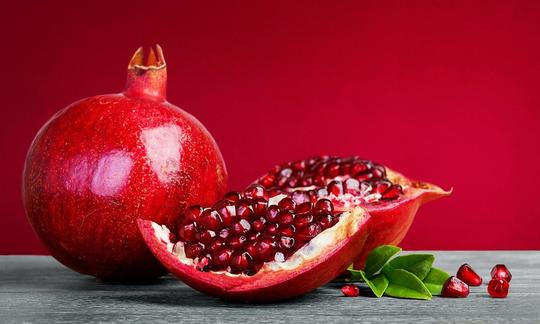

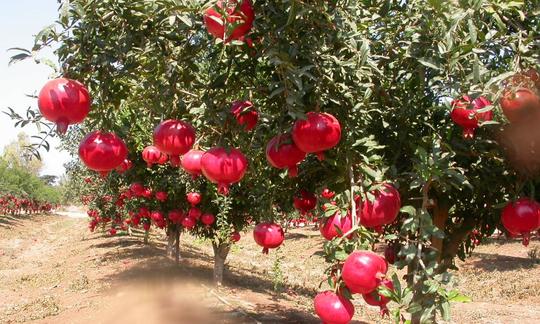

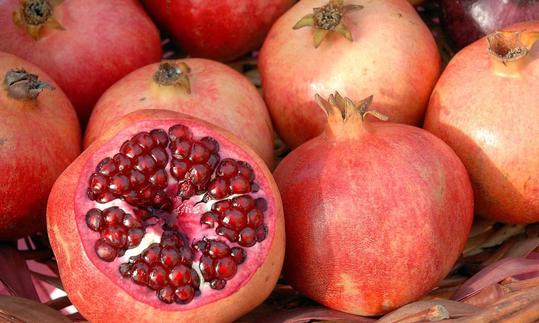

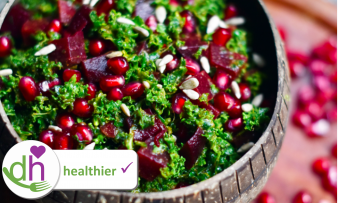
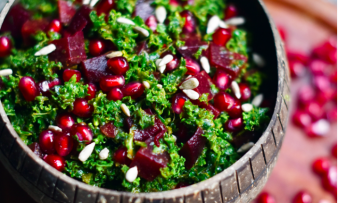
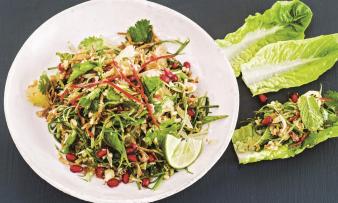





Comments